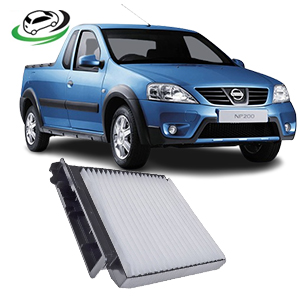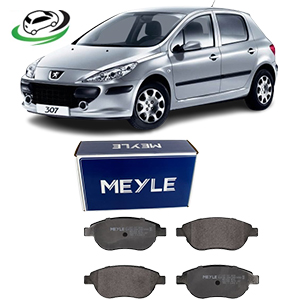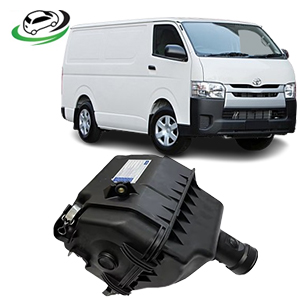-6%
Get Toyota Hiace KDH20# Air Filter Housing Assy 17700-30281
The air filter housing assembly is an essential part of a vehicle’s intake system. It houses the air filter and ensures that only clean air enters the engine, thereby protecting it from harmful debris, dust, and contaminants. The air filter housing assembly works in conjunction with the air filter to maintain the performance and longevity of the engine. In this comprehensive overview, we will explore the structure, function, importance, types, maintenance, and common symptoms of issues with the air filter housing assembly.
Structure of the Air Filter Housing Assembly
The air filter housing assembly is made up of several key components:
- Housing: The housing is typically made of high-quality plastic or metal and is designed to enclose the air filter securely. It forms a protective shell around the filter, shielding it from external elements like moisture, dirt, and debris.
- Air Inlet and Outlet: The housing has an inlet where outside air enters and an outlet that directs filtered air into the engine. These ducts or openings are strategically positioned to ensure optimal airflow.
- Lid or Cover: The air filter housing has a lid that can be easily opened or removed for air filter replacement. The cover is often secured with clips, screws, or fasteners to ensure a tight seal, preventing unfiltered air from bypassing the filter.
- Filter Sealing Gasket: Located around the perimeter of the filter, this gasket helps form a tight seal between the air filter and the housing. This ensures that all incoming air passes through the filter before reaching the engine.
- Maf Sensor Port: In many modern vehicles, the air filter housing assembly also includes a mounting location for the Mass Air Flow (MAF) sensor, which measures the amount of air entering the engine. This information is used by the engine’s control unit to regulate the air-fuel mixture.
Function of the Air Filter Housing Assembly
The primary role of the air filter housing assembly is to protect the air filter and guide clean air into the engine. Here are the key functions:
- Protects the Air Filter: The housing assembly shields the air filter from exposure to the elements, including rain, dirt, and debris. This protection helps the air filter perform efficiently and extends its lifespan.
- Directs Airflow: The housing ensures that all incoming air flows through the air filter, allowing the filter to trap contaminants. Once filtered, the clean air is directed toward the engine through the outlet ducts.
- Maintains Optimal Air Quality: By ensuring that only filtered air reaches the engine, the housing assembly helps maintain the proper air quality required for efficient combustion. Clean air improves engine performance and reduces the risk of damage caused by contaminants.
- Supports the MAF Sensor: For vehicles equipped with a MAF sensor, the housing ensures that the sensor is accurately positioned within the airflow. This allows for precise measurement of air intake, helping the engine control unit to regulate the air-fuel ratio for optimal combustion.
- Noise Reduction: The air filter housing also plays a role in reducing engine noise. By guiding airflow in a controlled manner, the housing minimizes the amount of noise generated by the air intake process.
Types of Air Filter Housing Assemblies
There are different types of air filter housing assemblies based on design, vehicle application, and performance needs:
- Stock Housing Assemblies: These are factory-fitted assemblies that come standard with most vehicles. They are designed for typical driving conditions and provide adequate protection and airflow for the engine’s requirements.
- Cold Air Intake Systems: In performance-oriented vehicles, a cold air intake housing is designed to pull cooler, denser air from outside the engine bay. Cooler air improves combustion efficiency and can enhance engine performance.
- Short Ram Intake Systems: These are designed to improve airflow efficiency by shortening the distance between the air intake and the engine. Short ram intakes provide more immediate airflow but may not cool the air as effectively as cold air systems.
- Aftermarket Air Filter Housings: Many performance enthusiasts opt for aftermarket housing assemblies that allow for improved airflow and better engine performance. These assemblies are typically made of lightweight materials and may feature larger or more efficient ducts.
Importance of the Air Filter Housing Assembly
The air filter housing assembly is essential for several reasons:
- Engine Protection: The air filter housing assembly plays a crucial role in protecting the engine from harmful contaminants like dust, dirt, and debris. Without this protection, these particles can enter the engine and cause damage to sensitive components like the cylinders and pistons.
- Efficient Airflow: By guiding the air through the filter, the housing assembly ensures that the engine receives the proper amount of clean air for combustion. This helps maintain fuel efficiency and optimal engine performance.
- Engine Longevity: Contaminants in the air can cause wear and tear on engine components. The housing assembly helps prevent this by ensuring that only clean, filtered air enters the combustion chamber, thus extending the life of the engine.
- Fuel Efficiency: Proper air filtration helps maintain the ideal air-fuel mixture required for efficient combustion. This, in turn, leads to better fuel economy and lower emissions.
- Environmental Protection: A well-functioning air filter housing assembly contributes to reducing emissions. By ensuring that the engine burns fuel cleanly and efficiently, it helps lower the amount of harmful pollutants released into the atmosphere.
Maintenance of the Air Filter Housing Assembly
Regular maintenance of the air filter housing assembly is crucial to ensuring optimal performance:
- Air Filter Replacement: The air filter inside the housing assembly should be replaced at regular intervals as specified by the vehicle manufacturer, typically every 12,000 to 15,000 miles, or more frequently in dusty conditions.
- Housing Inspection: During routine maintenance, inspect the housing for any cracks, damage, or warping that could allow unfiltered air to bypass the filter. A damaged housing should be replaced immediately.
- Cleaning: Clean the inside of the air filter housing during air filter replacement. Dust and debris can accumulate in the housing over time, potentially affecting airflow and filter performance.
- Sealing Gasket Inspection: Check the sealing gasket for wear or damage during filter replacement. If the gasket is worn or cracked, it should be replaced to ensure a proper seal between the filter and the housing.
- MAF Sensor Maintenance: For vehicles with a MAF sensor, ensure that it is clean and properly positioned within the air filter housing. A dirty MAF sensor can result in incorrect air-fuel ratios, leading to poor engine performance.
Symptoms of a Faulty Air Filter Housing Assembly
Several signs may indicate that the air filter housing assembly is damaged or needs attention:
- Reduced Engine Performance: If the air filter housing is cracked or improperly sealed, unfiltered air can enter the engine, leading to reduced power, poor acceleration, and overall diminished performance.
- Unusual Engine Noises: A damaged housing or loose components can cause rattling or whistling noises, especially during acceleration when the intake system is under load.
- Increased Fuel Consumption: If unfiltered air is bypassing the air filter, it can cause the engine to run inefficiently, resulting in increased fuel consumption.
- Check Engine Light: In some cases, a faulty air filter housing or MAF sensor (if located in the housing) can trigger the check engine light. This is often due to improper air-fuel ratios caused by inaccurate airflow measurements.
- Visible Damage: Regularly inspecting the air filter housing for cracks, warping, or loose fittings can help identify potential issues before they affect engine performance.
Conclusion
The air filter housing assembly is an integral part of a vehicle’s intake system, responsible for protecting the engine by ensuring that only clean air enters the combustion chamber. Its role in maintaining efficient airflow, protecting the engine from contaminants, and supporting the performance of the MAF sensor (when applicable) makes it a vital component for engine health. Regular maintenance of both the housing and the air filter ensures that the engine runs efficiently, which contributes to better performance, fuel economy, and reduced emissions. Understanding the structure, function, and importance of the air filter housing assembly empowers vehicle owners to take better care of their vehicles and extend the life of their engines.
Follow us on Facebook for more parts.



